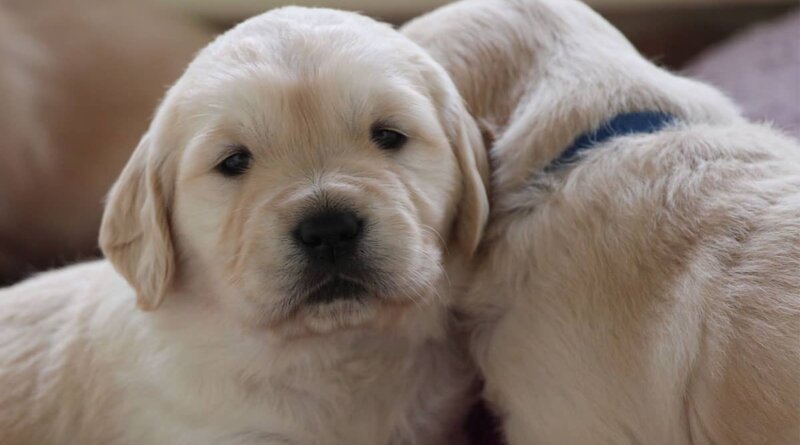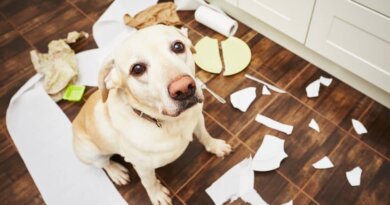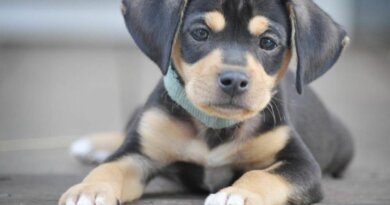Essential Tips For Your First Week With Your Puppy
This post may contain affiliate links. We may earn money or products from the companies mentioned in this post.
Bringing home a new puppy is so exciting!
They are so cute and playful. That is until they pee all over the house, destroy your favorite shoes, and leave you feeling like a zombie because they keep you up all night crying.
Well, you can avoid some of the downsides during the first week with your new puppy by checking out today’s article where we share our top puppy tips for the first week.
We have come up with a few top tips of what you should be doing in the first week with your puppy to help them get accustomed to their new home faster and kick start the essential training process.
A dog can bring a lot of joy to a household. This will only be intensified if you start out on the right foot by making sure the puppy’s first week at home is a good one.
Establish House Rules For Your Puppy
Before you bring your new pup home, it is a good idea to sit down with everyone in the household and establish puppy rules.
This is vital because puppies need consistency to learn. If they are allowed to do certain things when some family members are home and not others, they are going to get very confused, and it is going to be difficult to train them.
Decide things like where the puppy will sleep, what furniture they will and will not be allowed on (like beds and the couch), and whether there will be rooms that are always off-limits to the pup.
Also, decide the who, when, and where for important activities such as feeding, walking, grooming, training, and bathroom-ing.
Puppies thrive on routine and consistency, so they will learn faster if they have a regular schedule where they do the same things with the same people.
This can also be a good time to decide on key training words, including sit, down, off, stop, and so forth.
Again, the puppy will learn what these commands mean much quicker if everyone is using the same words (said the same way – consider your choice of words if you have different accents in the home) for the same purposes.
This may also be the time to choose a name for your dog.
They will need to learn this as quickly as possible, so it is a good idea to have a name everybody loves ready from the outset.
Finally, if you have kids in the house, make sure you teach them how to respect the puppy.
This can mean soft patting, not playing with the puppy’s toys, and not touching the puppy while they are eating or waking them while they are sleeping.
Puppy Proof Your House
We’ve all heard of baby-proofing the home. Covering electrical sockets and closing off dangerous stairwells before toddlers learn to start to move around on their own.
Well, you need to do the same things for puppies, though you’ll be looking at different things.
Remove everything you don’t want to be chewed from the floor or low tables and chairs.
This might include children’s toys, shoes, laundry (yes, they can pull things through those little holes in your laundry basket), remote controls, and electrical cords.
And, as well as the things you value, also remove things that might be dangerous. That means cleaning products, human food (many human foods are toxic to dogs), and cleaning supplies.
You don’t want them drinking out of a detergent bucket or chewing through a bag of powdered soap.
If there are things you can’t move, you can use a deterrent spray to try and keep your new pup away.
Sprays with a bitter or citrus taste will leave a bad taste in your new dog’s mouth and discourage them from chewing on things like the corners of furniture.
Just make sure to check that it doesn’t stain before coating anything.
We’ve been using Grannicks Bitter Apple Spray for years. However, there is a catch. Some dogs and puppies actually like the bitter flavor but you never know until you try it with your dog.
Remember that some house plants can also be toxic to dogs if they eat them and sometimes just if they rub up against them.
You can learn more about proofing your home here.
Don’t forget to block off stairs as puppies can easily have a tumble. It might take them a few weeks to figure out how to get up the stairs and even longer to learn how to get back down without tumbling.
Introduce The Crate
Crate training is one of the best ways to house train your new dog. But if you just pop them in the crate overnight from day one, it can be very traumatic and won’t help them learn.
So, take some time to get them used to the crate.
The first thing is to make the crate feel welcoming. For example, if you have received a blanket or anything else with the smell of their previous home, it is a good idea to place it in the crate to put that smell in there as well.
You can also add towels and bedding to make the crate comfortable, but expect this stuff to get destroyed.
Then let them discover the crate for themselves by leaving the door open and maybe placing some enticing treats inside.
You can praise the dog and give them treats when they do enter the crate. But don’t force them in, and don’t close the door with them inside right away. It shouldn’t feel like a trap.
Only when the pup starts coming in and out of the crate as if it is their territory can you start experimenting with closing the door.
Start by doing it just for a few seconds, and then increasing the time. Always open the door immediately if they start to become anxious.
It may take you a few days to get them used to the crate and, therefore, be able to start using it for house training.
Try And Get Through The Night
The first few nights are likely to be difficult. Your new pup will probably cry if they are not close to wherever you are, and yes, they may well wake up at 4 am with the desire to play with you.
So, the first thing is to accept that the first few nights are going to be difficult. But there are things to do to make it easier.
First, let them sleep close to you. While you might not want your bedroom to be their permanent sleeping space, they are going to make less of a fuss at night if they are near you.
There will be less crying and clawing at the door if they are on the inside.
Set up a sleeping space they can call their own within the room. This can be their crate, but if you aren’t crate training, set up a different bed.
You can try using a leash tethered to a piece of furniture to keep them in their bed and out of yours, but they may well not like that, especially if they aren’t used to the leash yet either.
PRO TIP: Our dog’s have chewed through leashes tethered to furniture. However, we regularly use a tie out cable to help manage our puppies. We like using a 4 foot tie out cable, but if you want to give your puppy more freedom you can get something longer.
Make sure there are toys and that blanket they have smells like home in their bed so they feel comfortable. And take them out to use the bathroom right before you put them to bed.
QUICK RECOMMENDATION: Our favorite first puppy toy is the Calmeroos Puppy toy w/ Heartbeat and Heat Packs. The Calmeroos Puppy is like bringing home one of your pup’s littermates and will help him feel more comfortable during his first nights home.
PRO TIP: If you get a Calmeroos Puppy bring it with you when you pick up your puppy and rub it all over his littermates. This will add the scent of his siblings to the toy you can put in his crate to help soothe him at night.
Start House Training
For both the sake of the smell of your home and the sake of effective training, you are going to want to start house training your new pup right away.
Very important in this process is watching your pup like a hawk! If they start nosing and pawing around like they are looking for somewhere to do their business, it is time to take them outside right away.
After they have done their business in the appropriate place, make sure to reward them with a treat. This reinforces the idea that going to the bathroom outside or in the agreed space is a good thing to do.
Don’t be tempted to yell at or punish your puppy if they do pee somewhere they shouldn’t.
This won’t necessarily teach them not to pee wherever it was that they were. It is just as likely to teach them not to pee when you are around.
The result?
You’ll find puddles of pee in unexpected places as they look to hide while doing their business.
Accidents will happen, and you will need to accept that on some level. But at least puppies tend to leave behind small puddles of pee that will be relatively easy to clean.
Nothing like the pools of pee that older and larger dogs have a tendency to leave behind.
Limit Visitors
While you will want to show your new puppy off to everyone, and there will be lots of people who want to come around for puppy cuddles, just say no in the first week.
Your new puppy will be getting used to a whole lot of new faces just with the household. If you add a bunch of visitors to this, it can just be stressful and confusing.
Take a week to get them comfortable with all of you first before hosting puppy play dates.
This goes double for children. Don’t let the neighbors’ children come around and play with the new puppy.
Kids don’t tend to have the requisite gentle touch for caressing new pups. They may also be tempted to do things such as play with the puppy’s toys or try and stroke the puppy when they are eating.
While we encourage our puppies to share their toys and be tolerant of others. During these early stages we’d like to get used to their new environment before adding any stress to their everyday behaviors.
Start Training
While house training is often considered the most important training when new pups come home (for good reason), you should get started on their training from day one.
Even if it doesn’t take right away, it will make the process faster, and it will also help prevent them developing bad habits that are hard to break.
The best training is to reward good behavior, reinforcing that this is the right thing to do, rather than punishing bad behavior.
Dogs can react in unexpected ways to punishment, and you might find they develop other bad habits, worse than the one(s) you are trying to change.
Threats don’t always have to be edible. A good belly rub and a fun game can be as rewarding to a pup as a tasty morsel. But food is the fastest way to reward them in the moment, and therefore, ensure they associate the reward with the activity.
For puppies, make sure that treats are small and low in calories. Otherwise, you might end up with an obedient but overweight pup. Some good options include:
You can find more tips for perfect puppy training here.
Other Consideration
- Don’t forget to register your dog with the local vet and take them for a visit within the first few weeks. While the breeder or shelter may have given you a fresh bill of health and said they are all up to date with the vaccinations, it is best to check this out.
- Make sure you are stocked up on everything you need (such as training treats and toys) before you bring your pup home. It will save you the stress of having to race off to the shops and will let your pup get used to “their stuff” from day one. For more information on exactly what you need to get your furry friend, check out this new puppy checklist that includes not only the essentials, but just about everything you’ll need for your pup.
- Don’t forget to buy an enzymatic cleaner like Rocco & Roxie’s Stain and Odor Remover. No matter how vigilant you are, it is going to happen.
Puppy’s First Week FAQs
What Should I Do When I Bring A Puppy Home?
When you bring home a new puppy, it is all about showing them that they are loved and safe, and teaching them the rules of the house. So, the best thing you can do in the first week is supervise them closely.
This helps the two of you build a bond so they feel safe. It also means you can put a stop to unacceptable behavior as it happens. No need to get mad or upset. Just show them what they should be doing, and reward them for complying.
Where Should A Puppy Sleep The First Week?
During the first week, if you can, let your puppy sleep in the room with one of the family members. They are likely to cry and scratch at the door if they are left alone during the night, so everyone will get a better night’s sleep if they are close by. It is also part of the bonding process.
If they are crate training, you can move the crate into the room. If not, create a separate bed for them. You can use a leash to keep them in the vicinity of the bed, but this can be challenging if they aren’t yet accustomed to the leash.
How Do You Settle A Puppy The First Night?
Help get your puppy to settle at night by tiring them out during the day with lots of play. Also, while puppies will sleep a lot during the day, don’t let them sleep in the three or four hours before bed time; this will help make sure they are tired when you are.
Also don’t give them food and water before bed, as this just increases the likelihood that they will need the bathroom during the night.
If possible, let them sleep in the same room as you. Proximity will help them feel safer and limit the likelihood of them crying through the night.
How Long Should My Puppy Be Left Alone During The Day?
While you want to slowly introduce your puppy to the idea of being left alone, you don’t want to leave puppies alone for more than about two hours at a time.
More time than this and they can start suffering from separation anxiety. Remember that up until this point they were probably always close to their mother and sibling puppies. More than this, and you are also more likely to encounter puddles of pee and deceased toys.
In the first week, two hours will probably be too long. You will want to start with 20 minutes and then gradually build up the time.
Should I Ignore A Puppy Crying At Night?
You shouldn’t completely ignore a puppy when they cry at night. They could be signalling to you that they need something (like the bathroom). However, it is also not behavior you want to reward with attention.
Try and create a situation that will limit their likelihood to cry, for example, by letting them sleep in the same room as you. If they are crying, perhaps let them see you so they calm down, but don’t reward them with a belly rub.
The Verdict
Bringing home a new puppy is both an unparalleled pleasure and a challenge. You want to do everything you can to make your new canine family member happy, but at the same time, it’s hard not to get frustrated when they pee on the carpet or keep you up all night with crying.
But there are things you can do to make acclimating a puppy to their new home easier.
Follow our tips for taking care of a puppy during the first week, and you’ll find that everyone feels happy and settled much faster.
Do you have any tips for a puppy’s first week at home?
Tell us about your experiences in the comment section below.
Save To Pinterest
Top Picks For Our Puppies
- BEST PUPPY TOY
We Like: Calmeroos Puppy Toy w/ Heartbeat and Heat Packs – Perfect for new puppies. Helps ease anxiety in their new home. - BEST DOG CHEW
We Like: Bones & Chews Bully Sticks – All of our puppies love to bite, nip, and chew. We love using Bully Sticks to help divert these unwanted behaviors. - BEST DOG TREATS
We Like: Crazy Dog Train-Me Treats – We use these as our high-value treats for our guide dog puppies. - BEST FRESH DOG FOOD
We Like: The Farmer’s Dog – A couple months ago we started feeding Raven fresh dog food and she loves it! Get 50% off your first order of The Farmer’s Dog.
Check out more of our favorites on our New Puppy Checklist.




